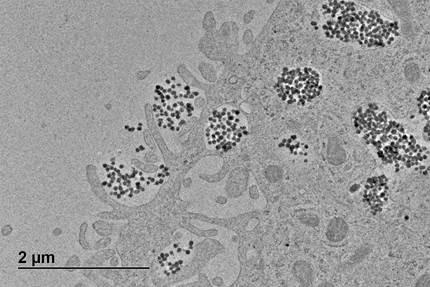
JRC scientists demonstrated the effect of silica nanoparticle agglomeration on the level and mechanism of their uptake by cells, i.e. agglomerated particles accumulated more in cells than non-agglomerated ones and presented a modified mechanism of cellular internalisation.
Silica nanoparticles (NPs) are increasingly present in variety of consumer products including cosmetics and food supplements.
They are in development for diverse medical applications such as drug delivery systems, tissue engineering and biosensors.
Silica nanoparticles can enter human cells via different mechanisms and induce intended (or not) biological effects.
They can subsequently accumulate in the cellular structures, degrade or be released from the cells and integrate the elimination system. Understanding which NP properties can influence this process provide an important information for designing of smart and efficacious nanoparticulate systems, but also allows reliable evaluation of their safety profile.
One of the predominant properties of NPs is their tendency to agglomerate, particularly in presence of the biological components.
In this study scientists from JRC have demonstrated that the mechanism of the internalisation of silica NPs can be modified following their agglomeration in the biological medium.
Furthermore, the amounts of agglomerated silica NPs accumulating in the cells were significantly higher compared to the non-agglomerated NPs.
These findings underline the necessity of thorough characterisation of NPs in the conditions of the in vitro study in order to draw relevant conclusions on the influence of their physicochemical characteristics on the biological effect.
Read more in: B. Halamoda-Kenzaoui et al. "The agglomeration state of nanoparticles can influence the mechanism of their cellular internalisation", J Nanobiotechnol, 2017, 15-48, doi:10.1186/s12951-017-0281-6.
Related Content
Details
- Publication date
- 24 July 2017
